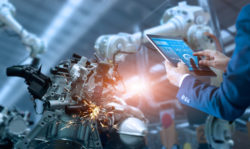Technological advancement is a wonderful thing.
The innumerable apps and gadgets that we can access in an instant help eliminate drudgery, improve efficiency and keep us all entertained.
Some may argue that the tactile pleasure of handling a book outweighs the convenience of a Kindle, or lament that the thrill of driving will be lost when we are all transported via autonomous vehicles, but it’s hard not to see the incredible changes we are witnessing as a net positive.
In the workplace, too, processes are improved, accuracy is ensured and backbreaking tasks are eliminated by the introduction of new technology.
But the road to the technological promised land is not always straight, and the human factor can create obstacles.
As we report here, one of the consequences of greater interaction between people and robots on the factory floor, for example, is fewer accidents as the machines almost faultlessly perform their tasks. When something does go wrong, however, injuries are more severe when the unstoppable power of the robots comes to bear on the soft tissue of human workers.
The human element in less physical jobs can also lead to unfortunate outcomes. A study recently released by specialty insurer The Doctors Co. showed that medical malpractice claims related to electronic health records are on the rise.
In one example in the study, an elderly patient had to visit an emergency room after her physician, intending to prescribe her Flonase nasal spray, entered “FLO” on a medication screen and the system selected Flomax, a medication for enlarged prostate, one side effect of which is hypotension.
Nobody wants to go back to deciphering physicians’ illegible scripts, but as electronic health record adoption is nearly universal, the risk of more typos leading to serious health problems rises.
The emergence of unforeseen and possibly catastrophic risk as a result of technological advancement is nothing new — machine-related deaths and injuries during the industrial revolution were horrific — but the pace of change we are currently witnessing creates a crucial need for improved risk management processes.
While risk managers are rightly wary of being labeled “the department that says no,” the need to step back and think through all the conceivable consequences of new processes and equipment has seldom been more urgent.
The tried and trusted risk management steps of risk identification, risk mitigation and risk transfer are even more vital when new processes are being introduced than they are for existing operations, but they must be applied across all departments.
A risk manager’s job may not be to put the brakes on technological progress, but by effectively partnering with colleagues across all of an organization’s operations, risk professionals may at least be able to make sure that seat belts are in use.



